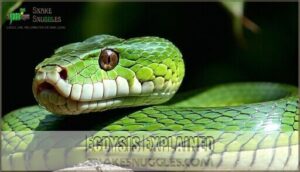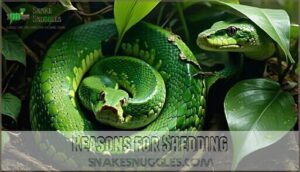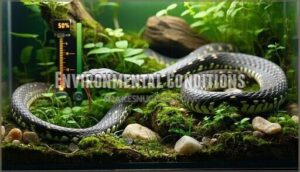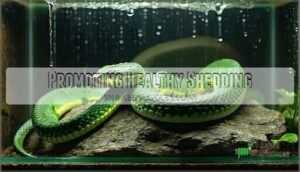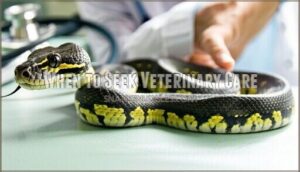This site is supported by our readers. We may earn a commission, at no cost to you, if you purchase through links.
 You’re looking at about one to two weeks for how long it takes for snakes to shed completely.
You’re looking at about one to two weeks for how long it takes for snakes to shed completely.
The whole process isn’t like peeling off a band-aid, though. Your snake’s skin will turn milky and opaque first, which can take up to a week before the actual shedding begins.
Then comes the main event where they’ll rub against rough surfaces to start peeling off that old skin like a tight sweater.
Young snakes shed faster than older ones, and species matters too. Environmental factors like humidity and temperature can speed things up or slow them down.
The trick is knowing what’s normal versus when something’s wrong.
Table Of Contents
- Key Takeaways
- How Long Does It Take for Snakes to Shed?
- The Snake Shedding Process
- Factors Affecting Shedding Duration
- Signs Your Snake is About to Shed
- Typical Timeline for Snake Shedding
- Variations in Shedding Time Among Snake Species
- Promoting Healthy Shedding
- When to Seek Veterinary Care
- Frequently Asked Questions (FAQs)
- How long does a snake shed?
- Do snakes shed their skin?
- How long does it take a Python to shed?
- Why is my snake shedding so long?
- What is snake shedding?
- What happens if a snake sheds a lot?
- How long does it take to shed a snake?
- Can a snake shed overnight?
- What are the signs of a reptile going through a shed cycle?
- How do you know when a snake is about to shed?
- Conclusion
Key Takeaways
- You’ll see the complete shedding process take one to two weeks, with a pre-shedding phase where your snake’s eyes turn cloudy and skin becomes dull, followed by the active shedding phase where they rub against surfaces to remove the old skin.
- Your snake’s age and species determine shedding speed – young snakes shed faster due to rapid growth while adults take longer, and some species like corn snakes can shed in 24 hours while others like boa constrictors need several weeks.
- You can speed up healthy shedding by maintaining 60-80% humidity levels and providing rough surfaces like branches or rocks for your snake to rub against, creating the ideal environment for smooth skin removal.
- You should contact a reptile vet if your snake’s shedding takes longer than two weeks or if pieces of old skin remain stuck, especially around the eyes or tail, as this can lead to infections or circulation problems.
How Long Does It Take for Snakes to Shed?
Most snakes take two to four weeks to complete their shedding cycle, though this timeline varies substantially. The shedding duration depends on several key factors that influence how quickly your snake can wiggle out of its old skin.
Most snakes shed their skin in two to four weeks, but some speedy species can slip out of their old outfit in just 24 hours.
During the pre-shedding phase, you’ll notice cloudy eyes and dull skin for about 1-2 weeks. This is when ecdysis timeframes really begin. The active shedding phase follows, where your snake rubs against surfaces to remove the old skin—another 1-2 weeks typically.
Species shedding rate plays a huge role here. Young snakes shed faster due to rapid growth, while adults take their sweet time. Initial shed timing for baby snakes can happen within hours of birth, but regular shed cycles follow different patterns.
Environmental conditions like humidity and temperature directly impact shedding frequency and shedding timeline. Snakes shed to facilitate growth and parasite removal, impacting the overall process. Understanding these shedding speed factors helps you provide proper care during this vulnerable period.
The Snake Shedding Process
When you watch your snake’s skin turn cloudy and see those telltale milky eyes, you’re witnessing ecdysis, the fascinating process where snakes literally outgrow their old skin like a teenager bursting out of last year’s clothes.
This natural skin renewal cycle serves multiple purposes, from allowing growth and removing pesky parasites to providing your snake with a fresh, healthy outer layer that’s ready for whatever comes next, which is a part of the snake’s natural development.
Ecdysis Explained
You’ve probably wondered what’s really happening when your snake starts looking a bit rough around the edges. Ecdysis is the scientific name for this fascinating skin renewal process that’s like nature’s ultimate makeover.
Here’s what makes ecdysis so remarkable:
- New keratin layer forms underneath the old skin, creating a fresh foundation
- Hormone regulation triggers the precise timing of when shedding occurs
- Complete replacement happens in one piece, unlike our daily skin cell loss
This sloughing benefits your snake in multiple ways beyond simple growth purposes. The shedding process removes parasites, bacteria, and worn-out scales while providing room for expansion. Understanding the shedding timeline helps you recognize when your snake’s entering this natural cycle and needs extra care.
Reasons for Shedding
Think of shedding as your snake’s way of hitting the refresh button. Growth drives this amazing process – as your snake gets bigger, its current skin becomes too tight, like outgrowing your favorite jeans.
Shedding is nature’s ultimate wardrobe upgrade—out with the old, in with the perfectly fitted new skin!
The shedding process serves multiple purposes beyond just making room. It’s nature’s way of maintaining skin health through complete regeneration.
When your snake sheds, it’s also doing some serious housekeeping. The old snake skin takes parasites, bacteria, and accumulated grime with it.
This natural repair system removes damaged tissue and replaces it with fresh, healthy skin. It’s like getting a brand-new protective suit that’s perfectly fitted for your snake’s current size and needs. Snakes often display increased hiding behavior during this time.
Factors Affecting Shedding Duration
While all snakes shed their skin, you’ll notice that the timing can vary quite a bit from one snake to another.
Several key factors determine whether your snake will shed quickly like a speedy corn snake or take its sweet time like some ball pythons, including their age, species, environment, and overall health.
Age and Species
Your snake’s age dramatically influences shedding frequency.
Your snake’s age has a significant impact, with juvenile shedding occurring 4-5 times yearly due to rapid growth rate, while adult frequency drops to 2-3 times.
Species variation matters too—ball pythons shed every 4-6 weeks, corn snakes every three months.
The first shed happens within weeks of birth, and different snake species follow unique patterns, making understanding your pet’s needs essential.
Adult snakes, however, experience less frequent shedding.
Environmental Conditions
Beyond age and species, your snake’s environment plays a huge role in shedding duration variability.
Think of it like creating the perfect spa day for your scaly friend.
Four key environmental conditions directly impact how smoothly things go:
- Humidity Importance – Keep levels between 50-70% to help old skin loosen naturally
- Temperature Effects – Consistent gradients support healthy skin cell renewal
- Substrate Choice – Rough textures provide necessary friction for rubbing off old skin
- Lighting Impact – Proper cycles regulate your snake’s biological clock and shedding timing
Health and Nutrition
Your snake’s overall health and nutrition directly impact how smoothly it sheds.
A balanced diet rich in proper nutrients guarantees consistent shedding frequency and complete skin removal.
Hydration importance can’t be overstated—dehydrated snakes struggle with stuck shed.
Poor snake nutrition leads to irregular cycles, while obesity prevention keeps metabolic processes running smoothly.
Don’t panic if your snake’s appetite disappears during shedding; this temporary fasting is normal.
As snakes grow, they rely on periodic skin replacement to accommodate their increasing size.
Supplement needs vary by species, but quality snake diet prevents anorexia causes and promotes snake health.
Signs Your Snake is About to Shed
You’ll notice your snake acting differently before it sheds, almost like it’s having a bad hair day that lasts about two weeks.
Your pet’s eyes will turn cloudy blue, its skin becomes dull and loose, and it’ll probably hide more while refusing its favorite meals.
Physical Changes
Watching your snake prepare to shed is like witnessing nature’s own makeover process.
The most obvious sign? Cloudy Eyes that turn milky white or bluish-gray, marking the start of the "blue phase."
This Color Changes signal kicks off your snake shedding timeline.
Your snake’s Dull Skin becomes the next telltale sign.
The vibrant patterns fade, looking washed-out and lackluster.
As shedding phases progress, you’ll notice Skin Loosening – it’ll appear baggy or wrinkled, like an ill-fitting sweater.
Scale Flaking might start appearing around the edges.
These physical transformations happen gradually over the shedding duration, typically lasting one to two weeks.
The skin literally separates from the new layer underneath, creating that loose, papery appearance.
Think of it as your snake outgrowing its old outfit.
During this shedding timeline, minimize handling since the loosened skin makes them more sensitive to touch.
Behavioral Changes
Physical signs aren’t the only clues your snake’s shedding process has begun. You’ll notice distinct behavioral changes that signal what’s coming next.
Hiding behavior becomes your snake’s top priority. That normally social ball python suddenly turns into a recluse, seeking dark corners and tight spaces. Increased aggression often follows – your docile pet might hiss or strike when approached.
Don’t take it personally; cloudy eyes limit their vision, making them feel vulnerable and defensive. Appetite loss is completely normal during this time. Most snakes refuse food entirely, so don’t worry if your pet skips meals.
Restlessness signs include frequent movement around their enclosure, rubbing against surfaces, and unusual activity patterns. Water soaking becomes common as snakes instinctively seek moisture to help loosen old skin.
These preshedding signs typically last one to two weeks, preparing you for the main event ahead.
Typical Timeline for Snake Shedding
You’ll want to know that the entire shedding process typically takes one to two weeks from start to finish, though it can feel like watching paint dry when you’re waiting for that perfect shed.
The timeline breaks down into two main phases: a pre-shedding period where your snake gets moody and cloudy-eyed, followed by the active shedding phase where they finally slip out of their old skin like taking off a tight sweater.
Pre-shedding Phase
Recognizing your snake’s preshedding signs is like reading nature’s calendar – it gives you a heads-up for what’s coming.
During this preshedding phase, lasting 1-2 weeks, you’ll notice distinct physical changes and behavioral changes that signal the shedding process has begun.
Your snake’s eyes will turn cloudy or develop that characteristic milky eyes appearance, often called the blue phase.
You’ll also see skin dullness as the old layer starts separating.
Appetite loss is common during this time, along with increased hiding behavior as your snake feels vulnerable.
Here’s what you should do during this sensitive period:
- Boost humidity to 60-70% to help loosen the old skin
- Minimize handling since your snake’s vision is impaired and stress levels are high
- Provide rough surfaces like branches or rocks for rubbing assistance
Active Shedding Phase
The active shedding phase is where the magic happens – your snake’s skin removal process kicks into high gear. Your scaled companion will start rubbing surfaces like rough bark or decorations to create that initial tear, usually beginning at the lips or nose.
This phase typically spans 24-48 hours, though some snakes take their sweet time. The snake’s outer epidermis constantly renews, allowing for this process.
| Timeline | Activity | What You’ll See |
|---|---|---|
| Hours 1-6 | Initial rubbing | Snake scratches nose/lips on surfaces |
| Hours 6-12 | Progressive peeling | Skin starts rolling back like a sock |
| Hours 12-24 | Shed completion | Most of old skin comes off |
| Hours 24-48 | Final touches | Last bits removed from tail/belly |
| Post-shedding | Recovery | Snake may rest, then resume normal behavior |
Some snakes practice eating shed skin afterward – perfectly normal behavior that helps replace lost nutrients during the shedding process.
Variations in Shedding Time Among Snake Species
You’ll find that shedding times vary dramatically between different snake species, kind of like how some people take forever to get ready while others are out the door in minutes.
Some snakes, like corn snakes, can complete their entire shed in just 24 hours, while others, such as certain boa constrictors, might take several weeks to finish the process.
Fast Shedders
Among snake species, you’ll find some are true fast shedders that complete their entire shedding process within 24 hours.
These speed demons include corn snakes and ball pythons, which have mastered the art of quick skin renewal.
Species Examples like these showcase how Genetic Influence plays a major role in shedding duration factors.
Juvenile Speed tends to be faster since young snakes shed more frequently due to rapid growth.
Dietary Impact and Stress Factors can also affect how quickly your snake completes ecdysis.
Shedding frequency varies substantially – some fast shedders might surprise you by completing the process overnight.
Warmer temperatures and ideal humidity often contribute to faster snake shedding duration.
However, remember that lightning-fast shedding isn’t always ideal.
If your snake shedding fast shedders seem unusually rushed, monitor them closely and consult a veterinarian if concerns arise.
Slow Shedders
Some snakes are the tortoises of the shedding world – slow shedders like Boa Constrictors and ball pythons can take several weeks to complete their molt. Python Shedding often falls into this leisurely category, where patience becomes your best friend.
Humidity Impact plays a massive role here. Poor moisture levels are the main culprit behind prolonged shedding in captivity. You’ll want to monitor these shedding duration factors closely – temperature fluctuations, seasonal changes, and hormonal shifts all influence timing.
Enclosure Design matters tremendously for these deliberate shedders. Mirror their natural habitat as closely as possible, maintaining proper humidity levels to prevent incomplete shedding or dysecdysis.
Don’t rush the process, even when it seems painfully slow. Forcing things can lead to complications requiring Veterinary Intervention. Let nature take its course – your snake knows what it’s doing.
Promoting Healthy Shedding
You can make your snake’s shedding process smoother and faster by creating the right environment in their enclosure.
Just like how you feel better in a comfortable room, your snake needs proper humidity levels and helpful surfaces to shed their skin without stress or complications.
Optimal Humidity Levels
While some species shed faster than others, getting your humidity levels right makes all the difference.
You’ll need to maintain 60-80% humidity during the shedding process – anything below 50% spells trouble.
Humidity monitoring with a reliable hydrometer isn’t optional; it’s your best friend for tracking environmental conditions.
A vital part of reptile care is using reliable humidity readers for accurate measurements.
When humidity problems arise, try misting techniques or adding a humidity box.
Optimal humidity levels prevent stuck sheds and keep your snake comfortable.
Remember, snake shedding humidity requirements vary by species, but staying within that sweet spot guarantees smooth sailing.
Too much moisture can be just as problematic as too little.
Proper Enclosure Setup
Beyond maintaining ideal humidity levels, your snake’s physical environment plays a major role in successful shedding. Think of it like creating a spa day for your scaly friend—they need the right tools and spaces to make the shedding process comfortable.
Your proper enclosure setup should include multiple hiding spots where your snake can retreat during this vulnerable time. A humidity box filled with damp sphagnum moss creates a microclimate that supports the shedding process. Don’t forget abrasive surfaces like branches or textured rocks—these help your snake rub off stubborn skin pieces. For consistent moisture, consider using a reptile enclosure humidifier.
Here’s your essential setup checklist:
- Humidity control box with moist moss for localized moisture
- Multiple hiding spots to reduce stress during shedding frequency cycles
- Abrasive surfaces like cork bark or rough stones for rubbing
- Substrate choice of orchid bark or cypress mulch to maintain environmental conditions
A shallow water bowl completes your snake shedding sanctuary, allowing soaking when needed. This temperature gradient setup guarantees your snake has everything necessary for smooth skin renewal.
When to Seek Veterinary Care
You’ll know it’s time to call a reptile vet if your snake’s been stuck in the shedding process for more than two weeks, or if pieces of old skin remain attached after what should’ve been a complete shed.
Think of it like a band-aid that won’t come off cleanly—sometimes your scaly friend needs professional help to avoid infections or circulation problems from stubborn skin patches.
Prolonged Shedding
A clock that won’t stop ticking can drive anyone crazy, and that’s exactly how your snake feels during prolonged shedding or dysecdysis. When your snake’s stuck in shedding mode beyond two weeks, it’s veterinary intervention time.
| Common Causes | Warning Signs |
|---|---|
| Humidity issues (below 50%) | Cloudy eyes lasting 3+ weeks |
| Nutritional deficiencies | Patchy, incomplete shed pieces |
| Underlying illness | Reduced appetite for weeks |
| Poor enclosure conditions | Visible stress behaviors |
Shedding problems stem from low humidity, poor nutrition, or health issues lurking beneath the surface. Don’t play doctor by removing stuck shed yourself—especially around delicate eye areas. Your vet can safely address incomplete shed and identify underlying causes, preventing future dysecdysis episodes.
Incomplete Shedding
Beyond prolonged shedding, incomplete shedding (dysecdysis) presents serious concerns for snake owners. When pieces of old skin remain stuck after two weeks, it’s time for veterinary intervention.
Stuck shed around eyes, tail tips, and between scales can cut off circulation or cause infections. Never attempt removing retained eyecaps yourself – you’ll risk permanent eye damage.
Here are three prevention tips to avoid shedding problems:
- Maintain 60-80% humidity during shed cycles
- Provide rough surfaces like bark or rocks for rubbing
- Offer a humid hide box with damp moss
Shedding aid products can help, but dysecdysis causes often include underlying health issues, poor nutrition, or environmental stress. Some owners find specialized products helpful for their snakes. Regular vet checkups catch these problems early, keeping your snake healthy.
Frequently Asked Questions (FAQs)
How long does a snake shed?
Like peeling off a tight sweater, your snake’s shedding process unfolds over one to two weeks.
You’ll notice cloudy eyes first, then the dramatic finale where they slip out of their old skin completely, which can be considered the dramatic finale.
Do snakes shed their skin?
Yes, snakes absolutely shed their skin.
It’s called ecdysis, and they do it regularly throughout their lives.
You’ll see them slough off their entire outer layer like peeling off a sock—pretty amazing, right?
How long does it take a Python to shed?
Pythons typically take one to two weeks to complete their shedding cycle.
You’ll notice cloudy eyes first, then clearing, followed by the actual skin removal.
Younger pythons shed faster than adults due to rapid growth.
Why is my snake shedding so long?
Just as a butterfly struggles to break free from its cocoon, your snake’s extended shedding might signal low humidity, poor health, or age.
Check humidity levels, make certain proper nutrition, and consider a vet visit if it’s taking weeks, which could indicate a more serious issue related to poor health.
What is snake shedding?
Snake shedding, called ecdysis, is your snake’s natural process of replacing old skin with fresh new skin.
It’s like getting a complete makeover – removing parasites, allowing growth, and keeping your snake healthy and comfortable.
What happens if a snake sheds a lot?
Like a broken record, frequent shedding signals rapid growth in young snakes or potential health issues in adults.
You’ll notice this happens when they’re growing fast, stressed, sick, or living in poor environmental conditions, which can be a sign of potential health issues.
How long does it take to shed a snake?
You’ll typically wait one to two weeks for your snake’s complete shedding process.
Younger snakes shed faster, while adults take longer.
Environmental factors like humidity and temperature can speed things up or slow them down substantially, affecting the complete process.
Can a snake shed overnight?
Fast-shedding species like corn snakes can absolutely shed overnight – it’s nature’s quick-change act.
While most snakes take 1-2 weeks total, you’ll witness the actual skin removal happening in just hours.
What are the signs of a reptile going through a shed cycle?
You’ll notice your reptile’s eyes turning milky or blue, skin becoming dull and loose, decreased appetite, increased hiding behavior, and restlessness.
They might also rub against rough surfaces more often during this uncomfortable pre-shed phase, which can be marked by restlessness.
How do you know when a snake is about to shed?
Your snake’s transformation begins like nature’s own magic trick – you’ll spot cloudy, milky eyes that look almost mystical, dull skin losing its shine.
Suddenly your normally social serpent becomes a hermit, hiding away mysteriously.
Conclusion
Understanding how long it takes for snakes to shed becomes much clearer when you know that healthy snakes typically complete their entire shedding cycle every 4-8 weeks.
Now you’re equipped with the knowledge to recognize pre-shedding signs, create ideal conditions, and identify when something’s wrong.
Remember, patience is key during this natural process.
By maintaining proper humidity levels and providing rough surfaces, you’ll help your snake shed successfully every time.
Monitor closely, but don’t stress if the timeline varies slightly, and focus on providing the right conditions for a successful shed, which is a natural process.
- https://teketrek.net/en/how-to-change-snake-skin/
- https://www.reconnectwithnature.org/news-events/the-buzz/nature-curiosity-why-do-snakes-shed-their-skin/
- https://mynatureguard.com/blog/do-snakes-stay-close-to-where-they-shed-their-skin/
- https://onlinelibrary.wiley.com/doi/full/10.1002/ece3.10364
- https://familysnake.com/guides/decoding-serpent-secrets-a-guide-to-understanding-your-snakes-behavior/

